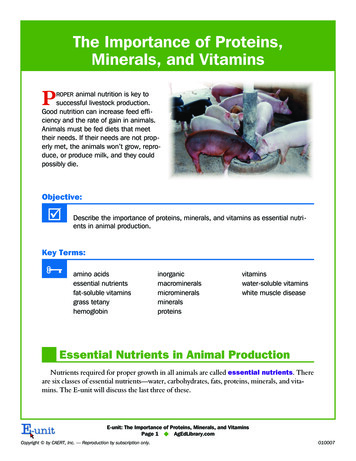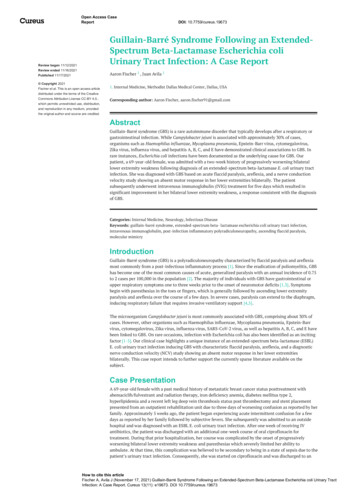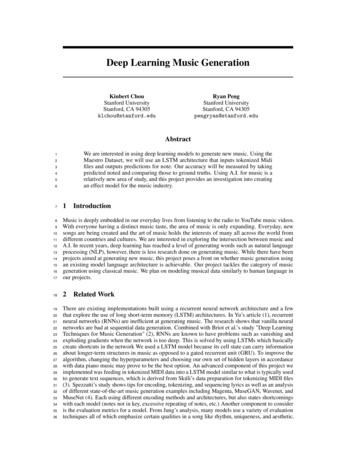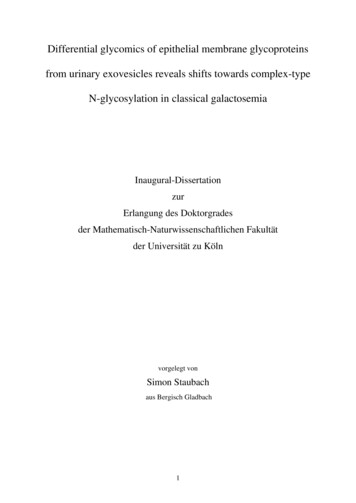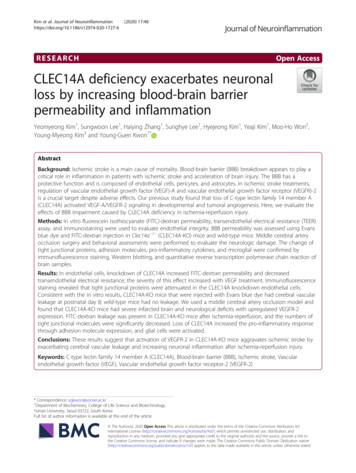
Transcription
Kim et al. Journal of 0-1727-6(2020) 17:48RESEARCHOpen AccessCLEC14A deficiency exacerbates neuronalloss by increasing blood-brain barrierpermeability and inflammationYeomyeong Kim1, Sungwoon Lee1, Haiying Zhang1, Sunghye Lee1, Hyejeong Kim1, Yeaji Kim1, Moo-Ho Won2,Young-Myeong Kim3 and Young-Guen Kwon1*AbstractBackground: Ischemic stroke is a main cause of mortality. Blood-brain barrier (BBB) breakdown appears to play acritical role in inflammation in patients with ischemic stroke and acceleration of brain injury. The BBB has aprotective function and is composed of endothelial cells, pericytes, and astrocytes. In ischemic stroke treatments,regulation of vascular endothelial growth factor (VEGF)-A and vascular endothelial growth factor receptor (VEGFR)-2is a crucial target despite adverse effects. Our previous study found that loss of C-type lectin family 14 member A(CLEC14A) activated VEGF-A/VEGFR-2 signaling in developmental and tumoral angiogenesis. Here, we evaluate theeffects of BBB impairment caused by CLEC14A deficiency in ischemia-reperfusion injury.Methods: In vitro fluorescein isothiocyanate (FITC)-dextran permeability, transendothelial electrical resistance (TEER)assay, and immunostaining were used to evaluate endothelial integrity. BBB permeability was assessed using Evansblue dye and FITC-dextran injection in Clec14a / (CLEC14A-KO) mice and wild-type mice. Middle cerebral arteryocclusion surgery and behavioral assessments were performed to evaluate the neurologic damage. The change oftight junctional proteins, adhesion molecules, pro-inflammatory cytokines, and microglial were confirmed byimmunofluorescence staining, Western blotting, and quantitative reverse transcription polymerase chain reaction ofbrain samples.Results: In endothelial cells, knockdown of CLEC14A increased FITC-dextran permeability and decreasedtransendothelial electrical resistance; the severity of this effect increased with VEGF treatment. Immunofluorescencestaining revealed that tight junctional proteins were attenuated in the CLEC14A knockdown endothelial cells.Consistent with the in vitro results, CLEC14A-KO mice that were injected with Evans blue dye had cerebral vascularleakage at postnatal day 8; wild-type mice had no leakage. We used a middle cerebral artery occlusion model andfound that CLEC14A-KO mice had severe infarcted brain and neurological deficits with upregulated VEGFR-2expression. FITC-dextran leakage was present in CLEC14A-KO mice after ischemia-reperfusion, and the numbers oftight junctional molecules were significantly decreased. Loss of CLEC14A increased the pro-inflammatory responsethrough adhesion molecule expression, and glial cells were activated.Conclusions: These results suggest that activation of VEGFR-2 in CLEC14A-KO mice aggravates ischemic stroke byexacerbating cerebral vascular leakage and increasing neuronal inflammation after ischemia-reperfusion injury.Keywords: C-type lectin family 14 member A (CLEC14A), Blood-brain barrier (BBB), Ischemic stroke, Vascularendothelial growth factor (VEGF), Vascular endothelial growth factor receptor-2 (VEGFR-2)* Correspondence: ygkwon@yonsei.ac.kr1Department of Biochemistry, College of Life Science and Biotechnology,Yonsei University, Seoul 03722, South KoreaFull list of author information is available at the end of the article The Author(s). 2020 Open Access This article is distributed under the terms of the Creative Commons Attribution 4.0International License (http://creativecommons.org/licenses/by/4.0/), which permits unrestricted use, distribution, andreproduction in any medium, provided you give appropriate credit to the original author(s) and the source, provide a link tothe Creative Commons license, and indicate if changes were made. The Creative Commons Public Domain Dedication o/1.0/) applies to the data made available in this article, unless otherwise stated.
Kim et al. Journal of Neuroinflammation(2020) 17:48BackgroundStroke is one of the most devastating neurological diseases and a major cause of long-term disability. Approximately 80% of strokes are ischemic [1, 2]. The standardtreatment for stroke is thrombolysis, which has ratherlimited efficacy [3, 4]. Ischemic stroke induces bloodbrain barrier (BBB) breakdown that contributes to secondary brain injury by causing cerebral edema, increasing hemorrhage, and exacerbating the inflammatoryresponse [5, 6]. The associated damage aggravates ischemic stroke injury and post-stroke deficits by decreasingthe capability of brain repair. The BBB has an importantprotective function [6]. It includes a basement membrane, endothelial cells (ECs), pericytes, and astrocyteend-feet that regulate the movement of molecules intothe brain [7]. Tight junctional proteins (e.g., Occludin,ZO-1, and Claudin-5) connect brain ECs to form theBBB [8]. Targeting the BBB may be a promising therapeutic approach for the treatment of ischemic stroke.Vascular endothelial growth factor (VEGF)-A is a crucial mediator of cerebral angiogenesis, and VEGF signaling pathways are potential therapeutic targets for stroke[9]. The VEGF-A/vascular endothelial growth factor receptor (VEGFR)-2 signaling pathway is essential for recovery from cerebral damage after ischemic stroke [10,11]. VEGFs likely have multifaceted actions in strokeprevention and therapy [12]. Despite the potential adverse effects of VEGFs (e.g., vascular permeability andbrain edema), the VEGF-A/VEGFR-2 signaling pathwayhas been used for acute or chronic treatment of stroke[9]. However, the effects of hyperactivation of VEGFR-2in stroke are not fully understood.The C-type lectin family 14 member A (CLEC14A)type I transmembrane protein belongs to the C-typelectin superfamily and includes an EGF-like domainalong with the C-type lectin domain [13]. Thecarbohydrate-binding protein C-type lectin domain mediates functions, including inflammatory responses andcell-to-cell adhesion [13, 14]. CLEC14A is specificallyexpressed in ECs in mouse and human vasculature [15].Accumulating evidence indicates that CLEC14A is acrucial regulator of physiological and pathological responses [16, 17]. Studies of CLEC14A in angiogenesis(e.g., cell-to-cell adhesion, endothelial migration, andtube formation) have been reported [13, 18]. CLEC14Aalso regulates proangiogenic phenotypes in various carcinomas [16, 17, 19]. Our previous study found thatCLEC14A interacts with VEGFR-3 and maintainsVEGF-A-induced VEGFR-2 levels in developmental andtumoral angiogenesis [20]. In this study, we usedCLEC14A knockout (KO) mice to evaluate the effectsof BBB hyperpermeability caused by VEGFR-2 activation. We found that regulation of BBB permeability iscritical for ischemia-reperfusion injury.Page 2 of 14MethodsCellsCollagenase type II (Worthington Biochemical Corporation, Lakewood, NJ) was used to isolate human umbilical vein endothelial cells (HUVECs) from umbilical cordveins. The cells were cultured on gelatin-coated plates inMedium 199 (Invitrogen, Carlsbad, CA; Thermo FisherScientific, Waltham, MA) supplemented with 20% fetalbovine serum, 100 U/ml penicillin-streptomycin, 3 ng/ml basic fibroblast growth factor (bFGF; R&D Systems),and 5 U/ml heparin. Trypsinization was used to collectthe cells, which were then used for assays up to passage7. Human brain microvascular endothelial cells(HBMECs; Applied Cell Biology Research Institute, Kirkland, WA) were used for assay up to passage 10. TheHBMECs were cultured on gelatin-coated plates andmaintained in endothelial cell basal medium-2 (CC3156) contained in an endothelial cell growth medium-2kit (CC-4176) (Clonetics, Lonza, Walkersville, MD) andin 20% fetal bovine serum.RNA interferenceHUVECs and HBMECs were transfected for 3 h withnon-targeting siRNA or CLEC14A siRNA using lipofectamine (Invitrogen, Thermo Fisher Scientific) andassayed 36 h after transfection. The sequence of theCLEC14A siRNA (5′-CAAUCAGGGUCGACGAGAA3′) was designed by Dharmacon Inc. (Lafayette, CO).In vitro permeability assayHUVECs and HBMECs were cultured on the luminalside of filters (0.4-μm pore size; Corning, NY) in gelatincoated 12-well plates until confluent. They were thencultured in endothelial serum-free medium (i.e., serumstarved) for 2 h and exposed to VEGF-A (50 ng/ml) for30 min. A Millicell ERS-2 V/ohm meter (Millipore, Billerica, MA) was used to measure the transendothelialelectrical resistance (TEER). The results for the cell-freegelatin-coated filter TEERs were subtracted from the results for the measured TEERs, and the final results werepresented in Ω cm2 units. Fluorescein isothiocyanate(FITC)-dextran fluorescein was used to confirm theparacellular permeability associated with the TEERmeasurement. FITC-dextran (1 mg/ml; Sigma, St. Louis,MO) was added to the upper compartments of thetranswell cultures. A FLUOstar Omega microplatereader was used to measure the values for absorbance ofthe lower chamber solution at 492 nm (excitation) and520 nm (emission) wavelengths.Immunofluorescence staining of HUVECs and HBMECsAfter fixation in 4% formaldehyde for 15 min at roomtemperature, the HUVECs and HBMECs were permeabilized in 0.1% Triton X-100 in phosphate-buffered
Kim et al. Journal of Neuroinflammation(2020) 17:48saline (PBS) for 15 min at 4 C. The cells were then exposed to antibodies [i.e., rat anti-VE-cadherin (1:200,Invitrogen), mouse anti-claudin-5 (1:50, Invitrogen),rabbit anti-occludin (1:100, Invitrogen), or rabbit antizonula occludens-1 (ZO-1, 1:200, Invitrogen)] overnightat 4 C. Cells were then incubated (1 h) at roomtemperature with Alexa Fluor-conjugated secondaryantibodies. To stain the nuclei, the cells were exposed to4,6-diamidino-2-phenylindole (DAPI) diluted (1:500) inPBS during the washing step. Dako mounting reagent wasused to mount the cells, and a confocal microscope (LSM700 META, Carl Zeiss) was used to examine the results.Western blot analysisProteins from ischemic hemispheres were extracted inradioimmunoprecipitation assay (RIPA) buffer (100 mMTris-Cl, 5 mM EDTA, 50 mM NaCl, 50 mM β-glycerophosphate, 50 mM NaF, 0.1 mM Na3VO4, 0.5% NP-40,1% Triton X-100, and 0.5% sodium deoxycholate). Sample protein concentration was quantified using aSMART BCA Protein Assay kit (iNtRON Biotechnology,Inc., Gyeonggi-do, Korea). Next, cell lysates (20 μg) wereseparated by sodium dodecyl sulfate-polyacrylamide gelelectrophoresis and then transferred to nitrocellulosemembranes. The membranes were blocked with 3% bovine serum albumin in 0.1% tris-buffered saline withTween 20 (TBST) and then probed with primary antibodies. The membranes were then incubated with horseradish peroxidase-conjugated goat anti-rabbit IgG orgoat anti-mouse IgG (Invitrogen) secondary antibodies.β-Actin was used as a loading control. The following primary antibodies were used at a 1:1000 dilution:CLEC14A (Santa Cruz Biotechnology Inc., Dallas, TX;sc-246,296), phospho-VEGFR2 (Cell Signaling Technology, Danvers, MA; 2478), VEGFR2 (Cell Signaling Technology; 2472), Claudin-5 (Invitrogen; 34-1600), Occludin(Invitrogen; 710,192), zona occluden-1 (ZO-1) (Invitrogen; 61-7300), and β-actin (Invitrogen; MA5-15739).Experimental animalsEach mouse (6 to 8 weeks of age) was maintained on aC57BL/6 background. The RPCI-22 Mouse 129S6/SvEvTAC Taconic BAC Library (https://bacpacresources.org)provided the CLEC14A clone. A Southern blot probewas synthesized to test the probe for embryonic stemcell screening. A CLEC14A-KO mouse construct wasgenerated using a pgkTK vector. The CLEC14A-KOmice were produced in a BacVac cassette using homologous recombination of Clec14a and LacZ Neo.Vascular permeability assayEvans blue (EB; 2% in PBS; Sigma-Aldrich, E2129) dyeand two different sizes of FITC-dextran (4 and 70 kD;Sigma-Aldrich, 46944 and 46945, respectively) were usedPage 3 of 14to evaluate cerebrovascular leakage. To test wild-type(WT) and knockout (KO) mice under normal conditions, the EB dye was injected via the intraperitonealroute 24 h before the brain tissue was removed andFITC-dextran (4 kD) was injected into the left ventricle30 min before the whole brain was collected. To performthe vascular leakage assay in the ischemic stroke mousemodel, FITC-dextran (70 kD) was injected (30 mg/ml)into the left ventricle and EB dye was injected via theintravenous route 30 min before the mice were sacrificed. EB leakage was quantified in the brain tissue afterthe brain had been homogenized and incubated in formamide (24 h, 55 C). The EB assay result was measuredin the supernatant from each sample (absorbance,620 nm). The EB concentrations were normalized basedon the results for the sham-operated brain samples. Theresults were calculated using a standard curve of EB informamide and were presented as microgram per gramof brain tissue.Cryosectioning and immunofluorescence stainingBrain tissue was exposed to paraformaldehyde (4%) andPBS (pH 7.4) overnight (4 C) for fixation. The tissuewas then rinsed with PBS at room temperature, incubated overnight (4 C) in sucrose (15%), and then transferred to sucrose (30%) at 4 C until the tissue sank.Tissue-Tek optimum cutting temperature (OCT) embedding medium was then used to infiltrate the fixedbrains for 30 min at room temperature. They werestored at 70 C after transfer to an OCT-filled embedding mold and freezing with dry ice. While frozen, sections (20- to 40-μm-thick) were cut onto slides at 20 C for immunostaining. The slides were stored at 70 C until use for this procedure. Briefly, the sectionswere prefixed in acetone for 30 min at 70 C andbriefly air dried. Flowing water was used to rinse theOCT. Each section was then exposed to blocking solution (1 h, 37 C). The sections were then incubated overnight in primary antibody (1:500, 4 C), washed threetimes (10 min per wash) with Triton X-100 (0.1%) inPBS, and incubated overnight in secondary antibody (1:500, 4 C). The sections were then counterstained usingDAPI (1 μg/ml) and washed five times with Triton X100 (0.1%) in PBS (10 min per wash). Antibody diluent(Dako, Agilent Technologies, Santa Clara, CA) was usedto dissolve each antibody. A confocal microscope (LSM700 META, Carl Zeiss) was used to examine each section.Induction of transient focal cerebral ischemiaAnesthesia using a mixture of 2.5% isoflurane (Baxtor,Deerfield, IL) in 33% oxygen and 67% nitrous oxide wasadministered to each mouse via a facemask. Two percentisoflurane was used for the maintenance anesthesia. Arectal temperature probe was inserted, and a heating pad
Kim et al. Journal of Neuroinflammation(2020) 17:48was used to maintain the body temperature (37 C).Middle cerebral artery occlusion (right side) was used toinduce focal cerebral ischemia [21]. Briefly, a midlinecervical incision was used to expose the right commoncarotid artery. After the right external carotid artery wasdissected free, it was isolated distally by coagulating itsbranches and placing a distal ligation prior to transection. A 6–0 fine middle cerebral artery occlusion(MCAO) suture (Doccol Corporation, Sharon, MA) wasinserted into the lumen of the right external carotid artery stump. To occlude the ostium of the MCAO, thesuture was carefully advanced into the internal carotidartery 8 mm from the bifurcation. The suture was removed after an hour of ischemia. After recovery anduntil euthanasia, each mouse was kept in a thermal incubator to maintain body temperature. The same surgicalprocedure was used for the sham-operated animals, butthe middle cerebral artery was not occluded.Inhibition of VEGFR-2Mice were subcutaneously injected with VEGFR-2 inhibitor (50 mg/kg), SU5416 (Tocris Bioscience, Bristol,GB), in solution (0.5% carboxy methyl cellulose, 0.9% sodium chloride, 0.4% polysorbate, 0.9% benzyl alcohol indH2O) after MCAO surgical procedure. WT and KOmice in untreated groups were given vehicle alone.Neurological deficitsNeurological scores were evaluated a day after inductionof transient focal cerebral ischemia (n 6 per group).The scoring system used was as follows: 0, no observableneurological deficits (normal); 1, failure to extend theright forepaw (mild); 2, circling to the contralateral side(moderate); 3, falling to the right (severe); 4, inability towalk spontaneously; and 5, depressed level of consciousness (very severe). Each animal’s score was estimatedwithin an approximate 1-min period and was estimatedin quadruplicate for consistency. Score values 0 wereused to indicate the presence of behavioral deficits; ascore of 0 corresponded to a normal neurological status.Measurement of infarct volumeA day after induction of transient focal cerebral ischemia, each mouse (n 6 per group) was anesthetizedusing pentobarbital sodium and then euthanized. Amouse brain matrix (L.M.S. Korea, Seongnam-Si, SouthKorea, L.R-68713) was used to section the whole brainsinto 2-mm-thick coronal slices. The brain slices werethen incubated in 2,3,5-triphenyltetrazolium chloride(TTC; 2%; Sigma-Aldrich, St. Louis, MO) for 20 min at37 C to reveal the ischemic infarction. After the TTCreaction was complete, ImageJ analysis software (version1.6 NIH) was used to measure the cross-sectional areasof infarction and non-infarction for each section. ThePage 4 of 14unstained areas indicated the presence of ischemic lesions. Infarct volume was calculated based on a 2-mmsection thickness. Each side of the brain sections wasmeasured separately, and mean values were calculated.Integration of four chosen sections was used to estimatethe total infarct volume. Each result was expressed as apercentage of the total brain volume.Immunofluorescence stainingFor immunofluorescence staining, each brain sectionwas incubated (2 h) in blocking solution at roomtemperature. Each section was then incubated at 4 Covernight with mouse anti-CD31 antibody (1:100; BDPharmingen), rabbit anti-ZO-1 antibody (1:100; Invitrogen), rabbit anti-occludin antibody (1:100; Invitrogen),rabbit anti-claudin-5 (1:50; Invitrogen) antibody, mouseanti-glial fibrillary acidic protein antibody (GFAP, 1:1000; Millipore, Burlington, MA), rabbit anti-Iba1 antibody (1:200; Wako, Richmond, VA), rabbit anti-VCAM1 antibody (1:100; Santa Cruz), or rabbit anti-ICAM-1antibody (1:100; Santa Cruz). Each section was washedfive times in Triton X-100 (0.1%) in PBS for 15 min, andthen incubated overnight (4 C) with secondary antibody. Before washing, each section was exposed to 1 μg/ml DAPI and washed five more times with 0.1% TritonX-100 (0.1%) in PBS for 10 min each. Each antibody wasdissolved in antibody diluent (Dako, Santa Clara, CA).The confocal images were recorded at room temperaturewith ZEN software and an upright confocal microscope(LSM 700; Carl Zeiss) using predefined ZEN softwareconfigurations for Alexa Fluor 594, Alexa Fluor 488, andDAPI.Quantitative real-time reverse transcription polymerasechain reactionTotal RNA (isolated from WT and CLEC14A-KO mousebrain after ischemia-reperfusion injury) was reverse transcribed to cDNA and amplified with the primers on aPikoReal 96 Real-Time PCR System (Thermo Fisher Scientific) using Maxima SYBR Green/ROX qPCR MasterMix (Thermo Fisher Scientific; catalog K0221) for quantitative real-time reverse transcription polymerase chainreaction (qRT-PCR) assays. All qRT-PCR assays wereperformed in triplicate in at least three independent experiments using two different samples. The PCR primersare listed in Table 1.Statistical analysisThe results were presented as mean standard deviationor mean standard error of the mean. GraphPad Prismsoftware (version 5.0; GraphPad Software, La Jolla, CA)was used for all statistical analyses. ANOVA with posthoc Bonferroni’s multiple comparison tests was used to
Kim et al. Journal of Neuroinflammation(2020) 17:48Table 1 Primer sequences used for GTTCAG-3’compare multiple group means. A P value of 0.05 wasconsidered to be statistically significant.ResultsCLEC14A deficiency increased endothelial permeabilityand decreased junctional integrityTo identify the effects of CLEC14A deficiency that increaseendothelial permeability, we performed in vitro vascularpermeability assays using FITC-conjugated dextran (70 kD,FITC-dextran) and TEER. HUVECs were monolayer-Page 5 of 14cultured, and CLEC14A were silenced using siRNA.HUVEC monolayer permeability to FITC-dextran was increased and became severe after treatment with VEGF(Fig. 1a). TEER was reduced in CLEC14A knockdownHUVECs, and there was more TEER decline with VEGFstimulation (Fig. 1b). The vascular integrity was determinedby examining junctional proteins. We tested the stability ofthe adherens junction protein, VE-cadherin, and the tightjunctional protein ZO-1 using immunofluorescence staining. CLEC14A silencing significantly attenuated junctionalprotein expression in the VEGF-treated condition (Fig. 1c).We used HBMECs to confirm the role of CLEC14A in theBBB. HBMECs were cultured using the same conditions asthe HUVECs, except for the culture media conditions. Wemeasured FITC-dextran permeability and TEER. HBMECsalso had increased endothelial permeability and decreasedTEER (Fig. 1d, e). These results indicated that CLEC14Acontributed to the stability of endothelial cell-to-cell junctions and vascular integrity.Increasing VEGFR-2 expression increased CLEC14A KOmouse brain injury in a cerebral transient focal ischemiamodelTo evaluate whether vascular defects occurred in thebrains of CLEC14A knockout mice, we used EB dye toFig. 1 CLEC14A knockdown decreased junctional integrity in ECs. a, d HUVEC and HBMEC monolayer permeability to FITC-dextran increased afterknockdown of CLEC14A using siRNA(50 nM) and treatment with VEGF (50 ng/ml, 30 min). Absorbance of the solution in the lower chamber wasmeasured after FITC-dextran was added to the transwell. b, e TEER was reduced by VEGF stimulation under the same conditions of thepermeability assay before FITC-dextran was added. The TEER was measured using a Millicell ERS-2 (Millipore). c Immunofluorescence staining ofVE-cadherin, ZO-1, and DAPI in untreated or VEGF-treated (50 ng/ml, 30 min) HUVECs after knockdown of CLEC14A. Each arrow indicates anattenuated junction. Scale bars: 20 μm. *P 0.05, **P 0.01, and ***P 0.001. The results are mean values and the error bars represent thestandard error of the mean values
Kim et al. Journal of Neuroinflammation(2020) 17:48reveal cerebral vascular leakage. EB dye was injected (intraperitoneal route) into postnatal day 8 mice; the micewere euthanized 1 day after injection. More vascularleakage was found in whole brains of CLEC14A KOmice than the wild-type (WT) littermates (Fig. 2a, b).However, brains of adult mice had no differences in BBBmaturation and angiogenesis (Fig. 2c, d). The BBB permeability to a smaller tracer (FITC-dextran; 4 kD) wasalso evaluated, and there was no significant difference ofFITC-dextran permeability in both WT and CLEC14AKO mice (see Additional file 1: Figure S1). Next, we useda focal cerebral ischemia model (MCAO) with WT andPage 6 of 14CLEC14A KO mice to examine the loss of CLEC14Aand high expression of VEGFR-2 during the pathologicalcondition. TTC staining was performed to evaluateinfarct volume 24 h after focal cerebral ischemiareperfusion. Infarcted regions were not detected in thesham groups. However, in the MCAO groups, theCLEC14A KO mice had severe infarction of the cerebralregions 24 h after ischemia-reperfusion, compared withthe WT group (Fig. 2e, f). Neurological scores were evaluated to examine the relationship between infarct volume and neurological impairment. The CLEC14A KOmice had higher neurological scores than those of theFig. 2 Loss of CLEC14A exacerbated cerebral injury with VEGFR2 activation in MCAO stroke model. a, c Images of whole brains and comparisonof Evans blue dye (EB) leakage in brains (P8 and adult) after EB injection (intraperitoneal route) in WT and CLEC14A KO mice (n 6, each group).b, d The quantitative analysis of Evans blue (EB) dye extravasation using spectrophotometer, 24 h after intraperitoneal injection of EB dye. e TTCstaining of brain slices in the sham, WT, and CLEC14A KO groups 24-h post ischemia-reperfusion. Severe infarction was present in the CLEC14AKO group. Scale bar 1 mm. f Percentage of infarct volume in the WT and CLEC14A KO groups 24 h after ischemia-reperfusion. g Neurologicalscores of WT and CLEC14A KO mice were evaluated. h VEGFR2, pVEGFR2 protein expression in ipsilateral brain lysate after ischemia-reperfusioninjury. i, j Quantification data of relative pVEGFR2 and VEGFR2 protein expression. n 6 per group; *P 0.05, **P 0.01, ***P 0.001. The resultsare mean values and the error bars represent the mean SD
Kim et al. Journal of Neuroinflammation(2020) 17:48WT mice (Fig. 2g). To support that these results wereassociated with vessel hyperpermeability caused by upregulated VEGFR-2 expression, we isolated whole brainsand used lysates of ipsilateral hemispheres to examineprotein expression after MCAO. In the sham group, theCLEC14A KO mice had slightly increased VEGFR-2 expression, but the phosphorylated VEGFR-2 level was notsignificantly changed in the CLEC14A KO mice, compared with the WT mice. However, both VEGFR-2 andphosphorylated VEGFR-2 expression were highly upregulated in the CLEC14A mice, compared with the WTmice, after ischemia-reperfusion injury (Fig. 2h–j). Theseresults suggested that upregulated VEGFR-2 caused byCLEC14A deficiency exacerbated the cerebral damagefrom ischemic stroke.CLEC14A deletion in mice increased cerebral vascularleakage after ischemia-reperfusion injuryTo test the effects of increased BBB permeability inCLEC14A KO mice after ischemia-reperfusion, FITCdextran was injected (transcardial) 24 h after ischemiareperfusion. Frozen sectioned tissues and immunofluorescence staining of cluster of differentiation 31 (CD31)were used to evaluate leakage of FITC-dextran. Theleakage was more intense in the ischemic cerebral cortexof CLEC14A KO mice, compared with WT mice (Fig. 3a,b). This increased leakage was also found in the ischemiccerebral subcortex (Fig. 3a, c). It has been shown thatcerebral ischemia induces opening of the BBB as early as2 h after stroke [22], so we evaluated the BBB permeabilityand cerebral injury at earlier time-points. The CLEC14AKO mice developed severe cerebral injury at 2 and 6 hafter ischemic stroke and showed more EB dye leakagethan WT mice (see Additional file 1: Figure S2A and B).Our results support the hypothesis that loss ofCLEC14A increases cerebral vascular permeability because of the attenuation in junction-related proteins thatoccurs after ischemic stroke. In the central nervous system, the tight junctions of cerebral ECs form a barrier torestrict paracellular permeability. The tight junctionalmolecules Occludin, Claudin-5, and ZO-1 wereimmunofluorescence-stained with endothelial markerCD31. After ischemia-reperfusion injury, Occludin,Claudin-5, and ZO-1 intensity remained relatively strongin the WT group (Fig. 4a). In contrast, expression oftight junctional proteins was significantly reduced in theCLEC14A KO group. The results for the quantificationof the data from the confocal microscopic images arepresented in Fig. 4b–d. We further tested the protein expression of tight junctions of the ischemic hemisphereusing Western blot analysis and found that CLEC14AKO mice had significantly decreased expression of thesemolecules compared with WT mice (Fig. 4e, f).CLEC14A deletion attenuated the BBB via decreasedPage 7 of 14endothelial tight junction expression and increased cerebral vascular leakage after ischemia-reperfusion.CLEC14A KO mice had an increased inflammatoryresponse caused by expression of adhesion moleculesand pro-inflammatory cytokines after ischemic strokeThe endothelial cell adhesion molecules ICAM-1 andVCAM-1 are important for mediation of tissue injuryduring ischemic stroke. In brain disorders, the BBB becomes impaired and many inflammatory factors are upregulated. These factors include adhesion molecules thatbind to leukocyte ligands and allow migration of leukocytes into brain tissue. Evaluation of the inflammatoryresponse using immunofluorescence staining of adhesionmolecules revealed BBB breakdown after the MCAOsurgical procedure. In the sham groups, WT and KOmice had little expression of ICAM-1 and VCAM-1.However, in the MCAO group, CLEC14A KO mice hadhigher levels of expression of adhesion molecules in thecerebral ischemic regions after ischemia-reperfusion injury than WT mice (Fig. 5a–c). To further support theeffect of CLEC14A deficiency on pro-inflammatory mediators, we confirmed the change of mRNA expressionby qRT-PCR. Pro-inflammatory cytokines, such as tumornecrosis factor alpha (TNF-α), interleukin 6 (IL-6), interleukin 1 beta (IL-1β), and monocyte chemoattractantprotein-1 (MCP-1), were significantly increased in theCLEC14A-KO mice after stroke (Fig. 5d–g). These results suggest that the inflammatory response was increased by BBB disruption through the high VEGFR-2expression associated with the pathological condition inCLEC14A KO mice.Activation of glial cells increased in CLEC14A KO miceafter ischemia-reperfusion injuryPerivascular cells (e.g., astrocytes and microglia) have animportant role in the neuro-inflammatory response induced by cerebral ischemic stroke. Astrocytes are themajor population of glial cells and maintain brainhomeostasis. We used immunofluorescence staining andobserved activation of GFAP-positive astrocytes in theischemic region to investigate differences in activated astrocytes in the cerebral ischem
verse effects of VEGFs (e.g., vascular permeability and brain edema), the VEGF-A/VEGFR-2 signaling pathway has been used for acute or chronic treatment of stroke [9]. However, the effects of hyperactivation of VEGFR-2 in stroke are not fully understood. The C-type lectin family 14 member A (CLEC14A) type I transmembrane protein belongs to the C .


